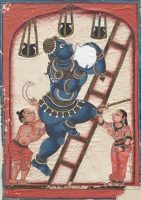CAA News Today
Millard Meiss Publication Fund: Apply Now + Congrats To Fall 2023 Grantees!
posted by CAA — January 22, 2024

Krishna Stealing Curds, late 1700s, Andhra Pradesh, Tirupati. Gum tempera and gold on paper, 10 ⅞ x 7 ⅝ in. (27.7 x 19.3 cm). The Cleveland Museum of Art, John L. Severance Fund 1966.28
CAA is now accepting applications for the Millard Meiss Publication Fund. Twice yearly, grants are awarded through this fund to support book-length scholarly manuscripts in art history, visual studies, and related subjects which have been accepted by a publisher on their merits but cannot be published in the most desirable form without a subsidy. Thanks to the generous bequest of late Professor Millard Meiss, CAA has been awarding these grants since 1975.
Visit our website to learn more about the application process, criteria, and to apply.
Deadline: March 15, 2024
Congratulations to the Meiss Fall 2023 Grantees!
Joanna Fiduccia: Figures of Crisis: Alberto Giacometti and the Myths of Nationalism, Yale University Press
Mayu Fujikawa: Envisioning Diplomacy: Images of Japanese Ambassadors in Early Modern Europe, Penn State University Press
Kelly Presutti: Land into Landscape: Art, Environment, and the Making of Modern France, Yale University Press
Paula Richman: The Work of Art: India’s Mithila Painting, University of Washington Press
Anna Seastrand: Body, History, and Myth: Early Modern Murals in South India, Princeton University Press
Alicia Volk: In the Shadow of Empire: Art in Occupied Japan, University of Chicago Press
AC2024 Edwards Memorial Support Grant Recipients Announced
posted by CAA — January 12, 2024
The CAA Edwards Memorial Support Grants, in memory of Archibald Cason Edwards Sr. and Sarah Stanley Gordon Edwards and made possible by Mary D. Edwards, support women who are emerging scholars and have received their PhD within the past two years or who are nearing the end of a doctoral program. Congratulations to the Annual Conference 2024 recipients, Daniella Berman and Phillippa Pitts!

Daniella Berman, Independent Scholar
Presentation: Revolution as Natural Disaster: Re-Framing 1789
Session: Disaster! Trouble in Eighteenth-Century Art
Presentation Abstract:
In Auguste Desperret’s lithograph, a volcano erupts the word LIBERTÉ. Lava cascades down, threatening to encircle successive cityscapes (representing countries at risk, identified by their flags) and sending figures – many in military uniform – running in the midground. In the foreground, the ruins of a castle bear the date 1789, surrounded by stone fragments inscribed with abandoned values including diving rights and feudalism. The sky is peppered with boulders bearing the words julliet, in reference to the July 1830 revolution.
Produced in 1833 for the satirical publication La Caricature, Desperret’s print Troisième eruption du volcan de 1789, reframes the impacts of the French Revolution as a natural disaster. In so doing, it draws on tropes prevalent in eighteenth-century dialogues inspired by Voltaire among others, that positioned the Revolution as a rupture, oftentimes violent, akin to natural phenomena. However, Desperret’s print calls into question how these natural disaster metaphors for the French Revolution and the St. Dominque revolt were utilized and transformed as the event was repeatedly reframed in the years following 1789 and well into the nineteenth century. What was the function of such analogies, and how were they visualized? This paper will explore the manifestations of Revolution as natural disaster across the material culture of the long eighteenth century, tracing the shifting dialogues that positioned the Revolution as a rupture or cyclical, as progress or failure, as upheaval or disruption, while considering the legacies of this rhetoric in the historiography of the Revolution and related visual material.

Phillippa Pitts, Boston University
Presentation: Fever Trees & Pharmacopeic Dreams: The Medical Manifest Destiny within Frederic Edwin Church’s Heart of the Andes
Session: U.S. Imperialism, Extraction, and Ecocritical Art Histories
Presentation Abstract:
Although often overlooked, the pursuit of health was central to the nineteenth-century ideas of empire that shaped both U.S. Americans’ imagined sphere of influence and the period’s enthusiasm for grand landscape painting. As the source of lifesaving cinchona, quinine, and diverse Peruvian elixirs, the Andes loomed particularly large in the antebellum imagination. Plays, panoramas, popular scientific texts, and patent medicine ads all cultivated popular interest in this supposed Edenic garden of health and abundance under perpetual threat of spectacular destruction by earthquakes and volcanoes. Taking Frederic Edwin Church’s The Heart of the Andes as its central case study, this paper recreates the conditions of vision in the antebellum city to reveal the underexamined pharmacopeic narratives within the painting and its dramatic performance. In doing so, it highlights how such displays of biodiverse abundance concealed the actual violence of botanical extraction. Indigenous and African laborers were, as one period observer noted, “made human sacrifices to furnish health to the white foreigners,” dying of disease as they carried the lifesaving treatments that would safeguard European and U.S. American imperial forces across the Global South. Today’s scholarly emphasis on the genocidal colonial excavation of Andean gold and silver has similarly elided the cultural, ecological, and human cost of extracting vegetable resources. Pairing insights from ecocriticism and critical disability studies, this paper argues for the importance of recognizing this medical Manifest Destiny, as well as artists’ role in naturalizing such discourse.
Art Journal / AJO Editorial Board seeks new members!
posted by CAA — January 08, 2024
CAA invites nominations and self-nominations for three individuals to serve on the Art Journal / AJO Editorial Board for a four-year term: July 1, 2024–June 30, 2028. Candidates may be artists, art historians, art critics, art educators, curators, or other art professionals; institutional affiliation is not required. Art Journal, published quarterly by CAA, is devoted to twentieth- and twenty-first-century art and visual culture. AJO is an online forum for the visual arts that presents artists’ projects, conversations and interviews, scholarly essays, and other forms of original content. Committed to fostering new intellectual exchanges in the fields of modern and contemporary art, AJO prioritizes material that makes meaningful use of the web and publishes on a rolling basis.
The editorial board advises the Art Journal and AJO editors-in-chief and assists them in identifying authors, articles, artists’ projects, and other content for the journal; performs peer review and recommends peer reviewers; guides the journals’ editorial programs and may propose new initiatives for them; promotes and advocates for both journals; and may support fundraising efforts on their behalf. Members also assist the editors-in-chief to keep abreast of trends and issues in the field by attending and reporting on sessions at the CAA Annual Conference and other academic conferences, symposia, exhibitions, and events.
The Art Journal / AJO Editorial Board meets three times a year, with meetings in the spring and fall plus one at the CAA Annual Conference in February. The fall and spring meetings are currently held remotely. Members are expected to pay travel and lodging expenses to attend the conference in February. Members of all editorial boards volunteer their services to CAA without compensation.
Candidates must be current CAA members in good standing and should not be serving on the editorial board of a competitive journal or on another CAA editorial board or committee. Members may not publish their own work in the journals during the term of service. CAA encourages applications from colleagues who will contribute to the diversity of perspectives on the Art Journal / AJO Editorial Board and who will engage actively with conversations about the discipline’s engagements with differences of culture, religion, nationality, race, gender, sexuality, and access. Nominators should ascertain their nominee’s willingness to serve before submitting a name; self-nominations are also welcome. Please email a letter of interest and a CV as a single PDF to Eugenia Bell, Editorial Director, ebell@collegeart.org.
Deadline: February 5, 2024


